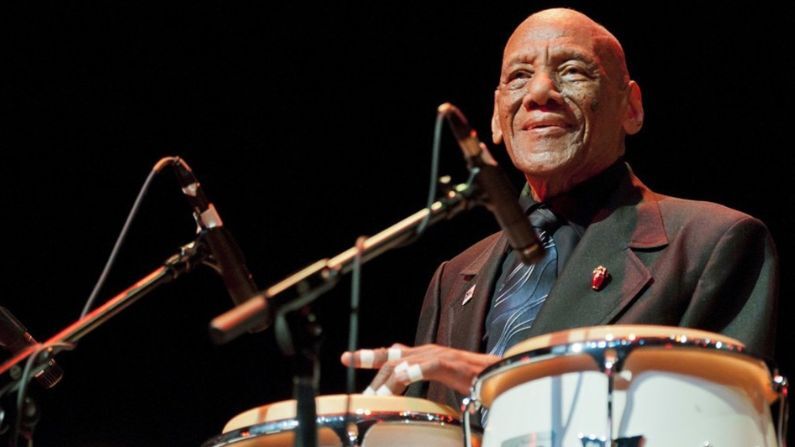Follow us on Spotify to keep up with our recent favorites.
In celebration of Hispanic Heritage Month (September 15 through October 15) we’ve created a playlist featuring artists of Hispanic and Latino descent. Featured are both classic material and modern jams from the subgenres of Latin jazz, boogaloo, samba, merengue, salsa, Latin rock and reggaetón, to name just a few.
Below is the entire playlist including my thoughts on a few favorites.
¡Disfrútalo!
Percussionist and bandleader Ray Barretto was the quintessential Nuyorican, a Puerto Rican born and raised in New York City. He spent his childhood in Brooklyn, Spanish Harlem and the Bronx, soaking up his surroundings as he matured. Initially intrigued by the sounds of bebop jazz, his exposure to trumpeter Dizzy Gillespie’s collaborations with Cuban conguero Chano Pozo cemented his passion for music and inspired him to dive headfirst into learning everything he could about the conga drum.
Barretto came into his own in the mid-1960s as a leader of a new subgenre called Latin boogaloo, a combination of son montuno, ch-ch-cha and R&B, which would later be known as salsa. The 1968 album, “Acid,” embodies the times with its combination of Latin, funk and soul music. The jazzy title track features a funky repetitive Afro-Cuban rhythm which supports a soaring muted trumpet solo propelling the listener through the track. Sprinkle some of Barretto’s conga magic on top and you have a perfect representation of that infamous Nuyorican attitude.
Willie Colón & Héctor Lavoe – La Murga
At the age of 15, American-born Puerto Rican trombonist Willie Colón was signed to the now legendary label Fania Records, helmed by composer and bandleader Johnny Pachecho. During the making of Colón’s first record, “El Malo,” Pachecho and his producers brought in vocalist Héctor Lavoe, starting a long-lasting creative relationship between the two young artists. With Colón now known as a pioneer of salsa music and Lavoe considered one of the most important singers in the history of the genre, the two made countless hits together over the years and directly contributed to Salsa’s overwhelming worldwide success.
One of those hits comes from a Christmas album called “Asalto Navideño,” which features salsa versions of classic Puerto Rican Christmas songs. The album’s name comes from the traditional custom of going door-to-door at Christmas time singing and “assaulting” the houses of good friends and neighbors with exuberant holiday cheer. The standout track “La Murga” hits the listener immediately with its wall of infectious horns, followed by playful melodic guitar, excellent percussion and, of course, Lavoe’s singing. A party hit for any time of the year!
Grupo Niche – Cali Pachanguero
Formed in 1979, the Colombian 15-piece band Grupo Niche came up with their biggest hit thousands of miles away during a gig in New York City. The group’s songwriter and percussionist Jairo Varela wrote “Cali Pachanguero” while feeling homesick and reminiscing about Cali, the bustling city he loved in Western Colombia known for its salsa scene and vibrant nightlife.
“Cali Pachanguero” was included on the band’s fourth studio album, 1984’s “No Hay Quinto Malo,” and found immediate success as it was named the official song of the annual Cali Fair the year it was released. The uptempo track features syncopated beats and the group’s signature metal arrangements – a mix of three trumpets, two trombones and saxophone – which have spun dancefloors into a frenzy for the last 40 years. The song launched Grupo Niche into the limelight and is now considered an anthem for Colombians and salsa lovers around the world.
Cuban conga and bongo player Cándido Camero Guerra was a pioneer of Afro-Cuban jazz and an innovator in percussion. He was the first to play multiple tuneable congas and developed techniques that many musicians use today including the simultaneous use of congas, bongos, and other instruments such as the foot-operated cowbell and attached guiro (a percussion instrument consisting of an open-ended, hollow gourd with parallel notches cut in one side).
Cándido already had a long and successful career when he released the album “Dancin’ and Prancin’” for the Salsoul label in 1979 at the age of 58. The record broke ground by combining Candido’s Latin conga beats with the popular four-on-the-floor syncopated disco rhythms of the time.
The album’s highlight for me is Cándido’s version of the African song “Jingo” by Nigerian percussionist Babatunde Olatunji from his debut album “Drums of Passion” released in 1959. “Jin-go-lo-ba” (or “Jingo”) means “do not worry” in Yoruba (Olatunji’s native language). The song was also covered by the Latin rock group Santana on their self-titled debut ten years later in 1969 (we feature that album’s closer “Soul Sacrifice” on the playlist as well).
Cándido’s interpretation of “Jingo” has become a go-to for any DJ looking to whip the dance floor into a frenzy with its dizzying percussion, soaring synths and tantalizing vocal grunts and chants. ¡Vamos!
Legendary Brazilian musician Sergio Mendes recently died in September and left behind an astonishing legacy. Known primarily for mixing bossa nova with American funk, Mendes was one of the biggest crossover Brazilian pop artists of his generation and released 35 albums throughout his illustrious career.
After decades of success, mostly in his adopted home of America, the 1992 album “Brasileiro” showcased a purposeful “back-to-Brazil” direction that reconnected the artist to his musical roots with its abundance of organically sourced Brazilian sounds.
The songs featured the upbeat sound with female voices singing in unison that Mendes was famous for, but it was now mixed together with different perspectives from Brazilian songwriters and instrumentalists to give it a totally authentic feel. Mendes’ aim was to explore a wide variety of rhythms, percussion, melodies and chants in Brazilian music to attempt to capture the power and energy you hear on the streets of Rio de Janeiro during Carnaval.
The jaw-dropping “Magalenha” is a fusion of northeastern and Bahian music penned by collaborator and songwriter Carlinhos Brown. At the start of the track, Brown is singing and playing triangle alone before being catapulted forward by both the Bahian percussion group Vai Quem Vem and a chorus of four women, three men and Mendes himself. This is Brazilian music at its finest.










